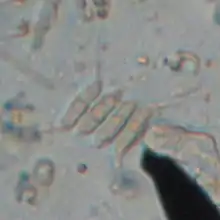Desmodesmus
Desmodesmus is a genus of green algae in the family Scenedesmaceae.[1] It is the only chlorophyll-containing organism known to have caused human infections in immunocompetent individuals. All known cases involved open injuries occurring in fresh water.[2]
| Desmodesmus | |
|---|---|
 | |
| Desmodesmus armatus | |
| Scientific classification | |
| (unranked): | Viridiplantae |
| Division: | Chlorophyta |
| Class: | Chlorophyceae |
| Order: | Sphaeropleales |
| Family: | Scenedesmaceae |
| Genus: | Desmodesmus (Chodat) S.S.An, T.Friedl & E.Hegewald |
| Species | |
| |
Description
Desmodesmus consists of colonies of two, four, eight or 16 cells arranged in a row. Cells are ellipsoidal to ovoid, joined to each other by their longer sides. The terminal cells of a colony (and sometimes the medial cells as well) are usually armed with spines. Cell walls may also be covered in ridges, warts, and net-like structures. Cells contain one parietal chloroplast, containing one pyrenoid.[3]
Habitat
Desmodesmus is found in the plankton of habitats such as ponds and lakes, particularly in eutrophic waters.[4] It is one of the most common types of freshwater plankton.[3]
References
- See the NCBI webpage on Desmodesmus. Data extracted from the "NCBI taxonomy resources". National Center for Biotechnology Information. Retrieved 2007-03-19.
- Westblade, Lars F.; Ranganath, Sangeetha; Dunne, William Michael; Burnham, Carey-Ann D.; Fader, Robert; Ford, Bradley A. (2015-03-05). "Infection with a Chlorophyllic Eukaryote after a Traumatic Freshwater Injury". New England Journal of Medicine. 372 (10): 982–984. doi:10.1056/NEJMc1401816. ISSN 0028-4793. PMID 25738686.
- Shubert, Elliot; Gärtner, Georg (2014). "Chapter 7. Nonmotile Coccoid and Colonial Green Algae". In Wehr, John D.; Sheath, Robert G.; Kociolek, J. Patrick (eds.). Freshwater Algae of North America: Ecology and Classification (2 ed.). Elsevier Inc. ISBN 978-0-12-385876-4.
- Hegewald, Eberhard; Braband, Anke (2017). "A taxonomic revision of Desmodesmus serie Desmodesmus (Sphaeropleales, Scenedesmaceae)". Fottea. 17 (2): 191–208. doi:10.5507/fot.2017.001.